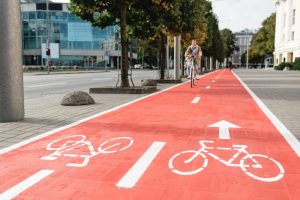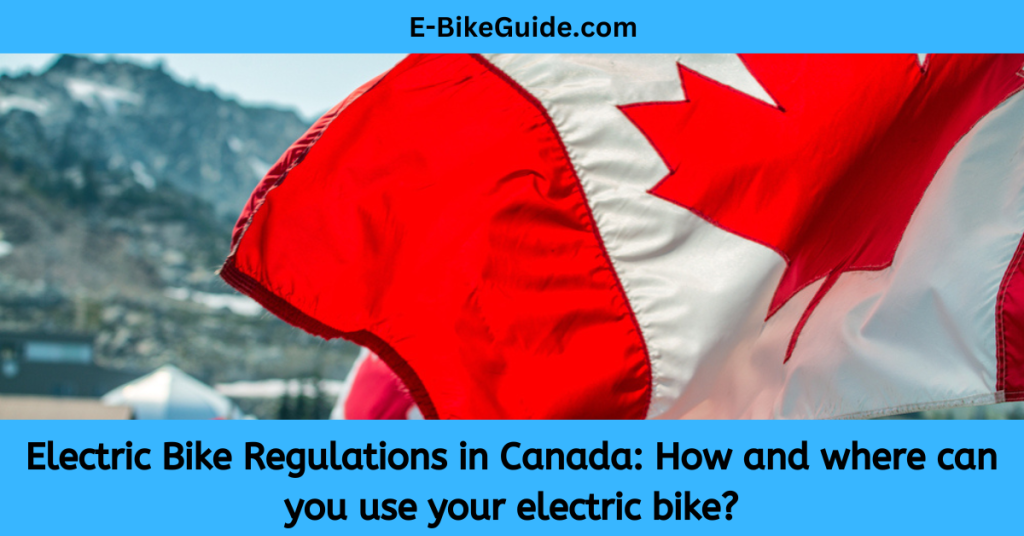Since their invention in the later part of the 19th century, electric bikes (e-bikes) have been gaining popularity worldwide. In Canada, e-bikes are subject to the same rules and regulations as traditional bicycles, with a few differences. Here’s a guide to help you understand where and how to use your e-bike in Canada.
Electric bikes are becoming more and more popular in many countries. The reason is that they offer a green transportation method with zero emission production. Electric bikes are also a fun way to get around and are used for commuting or fun. To use an electric bike safely and legally, it is essential to know the rules in your country or area. Based on your hometown, there may be different rules for electric bikes. For example, in the United States, electric bikes are also “low-speed electric bicycles.” Laws and language change, anyway. While some nations have national laws, others let the states and areas of a country decide whether or not using the roads is legal. city-based rules create more challenges.
Ebikes in Canada

It’s simple to own an electric bike in Canada. The rules for these vehicles are almost the same as those for ordinary bicycles. They are power-assisted bicycles, electric scooters, e-bikes, and e-scooters. They don’t need a permit, license, or insurance for ownership or operation. In Canada, the grouping of power-assisted bicycles is been in governance by united governments law, with certain minor differences by areas of the country, such as the least possible age restrictions. Also, the places where they may be useful as subject to change by each great town.
Surrounding regulations to ride an e-bike in Canada
However, before you go out and buy an e-bike, there are a few facts that you need to know about the rules surrounding their use. Here are the points that you need to know about electric bike rules in Canada. Before riding your electric bike on a trail, make sure to check the rules with the track manager. The electric bike, or e-bike, is a popular choice for getting around these days, and it’s not hard to see why. E-bikes are environmentally friendly, they’re low in price and they’re a great way to get some exercise.
This means they have a limit of speeds of 20 miles per hour or less. Also, electric bikes must have a less than 750 watts motor. Electric bikes, also known as e-bikes, are becoming increasingly popular in Canada. With their ability to give riders a boost when pedaling, they make riding up hills and long distances much easier to get to. And, with many models now available that look just like regular bicycles, they are an excellent option for those who want to get around without using a car.
Where can you ride your electric bike?

In Canada, you can ride your electric bike on any road where bicycles are permitted. This includes city streets, bike paths, and even some off-road trails. However, there are a few places where e-bikes are not useful. You cannot ride your e-bike on: Sidewalks, pedestrians, crosswalks, or Highways. Also, some provincial and land-based parks where e-bikes are not useful. Be sure to check the rules in your area before riding in a park.
Electric Bike Regulations in Canada
In Canada, the rules are almost the same, but the speed limit is 18.6 miles per hour. Electric bikes in Canada must also have a motor that is less than 500 watts. Electric bikes have a must to have brakes and lights. In Canada, electric bikes are given grouped into “power-assist bicycles” or “limit-speed motorcycles.” Power-assist bicycles have a limit of 32 kilometers per hour and have a motor of fewer than 500 watts. Limit-speed motorcycles have a limit of 70 kilometers per hour and have an engine of fewer than 1,000 watts.
Power-assisted bicycles (PAB) and Low-speed vehicles (LSV)

In Canada, electric bikes are given groups as “power-assist bicycles.” This means they can have a motor of up to 500 watts. Electric bikes in Canada also have a limit of 20 miles per hour or less. also, electric bikes must have a motor of fewer than 500 watts. And also, electric bikes are considered “power-assist bicycles” and are subject to the exact rules and regulations of regular bicycles. Here’s a list of what you must have in your mind before you hit the road on your e-bike. E-bikes are given groups as either low-speed or high-speed. Low-speed e-bikes have the highest speed of 20 km/h (12 mph) on level ground, and high-speed e-bikes can reach speeds of 32 km/h (20 mph) on level ground.
E-bikes are useful on most trails and pathways, but some limits are there may be in place depending on your local city. Always check the signs before you ride to make sure you follow the rules. You can generally ride your electric bike on any road or trail where regular bicycles are useful. This includes most city streets, bike lanes, and multi-use trails. However, there are a few flaws to this rule. Electric bikes are not allowed on highways or expressways, even if regular bicycles are useful. They are also not used on any road or trail where motor vehicles are not useful.
Classification of Ebikes based on speed and motor power
Depending on their top speed and motor power. PABs have a motor with the highest power output of 500 watts and a top speed of 32 km/h, while LSVs have an engine with the highest power output of 750 watts and a top speed of 25 km/h.
Some areas of a country and territories have extra rules about where electric bikes can be useful. For example, in Ontario, electric bikes are not useful on trails whereas snowmobiles are useful. In most areas of the country and land-owned areas, PABs are given consideration as the same as traditional bicycles. and they can be useful on roads, bike lanes, and trails. LSVs, on the other hand, are subject to different rules and regulations depending on the city-based land or territory.
Most e-bikes have the greatest weight limit of 120 kilograms (265 lbs 1 electric 2-wheelers, or e-bikes, and have been getting more conditions of having general consent in near time years. An e-bike is a 2-wheeled vehicle that has an electric engine that helps the horseman. E-bikes are the best way to get around, whether you are going to work or school, running journeys, or just getting out for a leisurely go on (transport). There are a few facts to consider if you consider taking a journey on an e-bike in Canada 2. First, you must make certain that your e-bike has meeting with the lawfully needed things. Second, you need to have an understanding of where you can and can not go on (transport) your e-bike
Where you can and cannot ride an electric bicycle

In common, you can ride your e-bike on the road in the same places as regular bicycles. However, some areas of a country and territories have different rules in place. For example, in Ontario, e-bikes are not useful on 400-series highways (such as the 401) or expressways (such as the Queen Elizabeth Way). In Ontario, for example, LSVs are useful on paths with a speed limit of 50 km/h or less and on trails that are not part of the provincial highway system. In British Columbia, LSVs’ electric bike rules in Canada governs by the city-based area or territory in which you live. There are different rules in each province and territory, so it’s important to know what applies to you.
now, 10 Canadian provinces permit the usage of Ebikes. Alberta, British Columbia, Manitoba, New Brunswick, Newfoundland & Labrador, Nova Scotia, Ontario, Prince Edward Island, Quebec, and Saskatchewan. these are the provinces that have established Ebikes rules. While each area of land has its own set of rules (more on that below), in general, if you obey the one’s list below, you should be in obedience to Canadian laws controlling/ruling electric bikes. Before you go on the road, be sure you understand these basics.
Here’s a list of the rules in each province and territory:
Alberta
In Alberta, electric bikes are like regular bicycles. That means you can use them on the road, on bike paths, and in most places where bicycles are useful.
There are some odds, however. For example, you may not be able to use your electric bike on particular trails or in national parks.
British Columbia
In British Columbia, electric bikes are like regular bicycles. That means you can use them on the road, on bike paths, and in most places where bicycles are useful.
Ontario
The highest weight limit for an e-bike in Ontario is 120 kg, and the highest stopping distance is nine meters. A vehicle that weighs more than this is no longer an e-bike by law. Riders must be at least 16 years old. cities may also set limits on particular e-bike models and place restrictions. places where they may be useful on local streets, bike lanes, and trails.
Manitoba
Manitoba suggests e-bikes must have at most three wheels touching the ground. Riders must also be at least 14 years of age or older.
New Brunswick
The laws in New Brunswick are a bit different. The seat of an electric bike must be 68 cm from the ground, and the tire rims must be more important than 22 cm. If the rider uses the electric bike at night, it must also have a headlight. In New Brunswick, there isn’t a fixed age limitation for using an e-bike right now.
Nova Scotia
Power-assist bicycles are separate and label as the same regular pedal bicycles in Nova Scotia. The chin strap of the riders is useful if the cycling helmet is tight enough.
Prince Edward Island
There are a few differences between Prince Edward Island and other areas of the country. Only in the area of Prince Edward Island are e-bikes separate and label as limit-speed motorbikes. and produce with the same legal protections as mopeds and electric motorcycles. As a result, cyclists need a license, and e-bikes must be registered. Users must be at least 16 years old.
Quebec
also, to follow the general rules, e-bikes in Quebec can have up to three wheels and need to have the manufacturer’s original label attached. To ride an electric bicycle, a rider must be at least 14 years old. and if they are younger than 18, getting a moped or scooter license is a must (A class 6D license)
Saskatchewan
Electric-assist bicycles, which use both pedals and a motor at once. and power cycles, which use either pedals and an engine or motor. these are the two categories of power-assisted bicycles in Saskatchewan. The power cycle must stick to Canadian Motor Vehicle Safety Standards (CMVSS) for a power-assisted bicycle. At the very least, a learner’s permit is a must in the power cycle. There are no licenses or registration for electric-assist bicycles. Riders must be at least 14 years old.
New found land and Labrador.
E-bikes must have a white front light, a reflector, and a red rear light. While riders between the ages of 14 and 17 need an approved permit to drive a scooter. The e-Bike, moped, and those above the age of 18 do not need to have a license or registration.
Northwest Territories
Riders must obey federal laws since the federal government leads and controls them in the territories.
Universal regulations that apply to all-electric motorcycles in Canada

The following rules apply to electric motorcycles in all Canadian areas of a country (with the exception of Prince Edward Island, which has its own set of regulations):
Motor output is limited to 500 W; on flat land, motor power alone cannot move a vehicle faster than 32 km/h.
Steering handlebars and properly functional pedals are a must for e-bikes. When the rider stops pedaling, the bike runs itself by the battery, and the engine must shut off.
The vehicle’s motor can not ever undergo any modifications to produce speeds greater than 32 km/h (20 mph).
The official technical names for an electric bicycle are “assist bicycle” or “power-assisted bicycle” (PABs). This only applies to bicycles with electric motor help; internal combustion engine vehicles are not in consideration
Every rider must always wear a helmet whether riding a bike or a motorcycle.
There must be clear labeling on e-bikes stating that they follow all relatable federal and relate to all local area rules.
An engine that runs on electricity rather than gas is needed for an e-bike to be separated and labeled it
Which roads are useful for electric bike use?
Ebikes may go on and share the roads and trails with other bicycles and vehicles just like regular human-powered bicycles do. Again, before you ride, make sure to check your province’s laws and keep up with any changes.
Among the important laws in some provinces are:

Riders in Ontario can use their e-Bikes on most of the roads and highways where regular bicycles are useful. The 400-series motorways, expressways, and other places where bicycles are not useful are exceptions.
Also, cyclists are not capable to ride on city-based roadways, including sidewalks, where by laws prohibit them. Also, e-bike riders are not useful to use trails, routes, or lanes, which clearly shows that e-bikes are not useful.
E-bikes are lawfully useful on highways in Nova Scotia.
Electric bicycles are legal on all roads in Quebec, leaving out highways (which include their exit and access ramps)
All electric bicycles are useful only on British Columbian roadways, and class 1 e-bikes are useful on any trails that
Further in British Columbia, class 1 e-bikes can ride on any trail. Also, mountain bikes and other forms of cycling are already useful. All ebikes are useful on roads. You can use them on trails and roads that are for motor vehicles if you have a class 2 or 3 bike.
Other than the motor output, speed, helmet usage, and age limit. and there aren’t many strict rules on e-bikes in Canada. Though there are some differences in the laws between the areas of the country. To make sure you and your vehicle are sticking to all the legal needed things. And it is best to teach yourself the e-bike rules in your city-based area before buying or using your vehicle.
Now that you know all the rules and regulations for electric bikes in Canada and its provinces. All you just need is an eBike.
